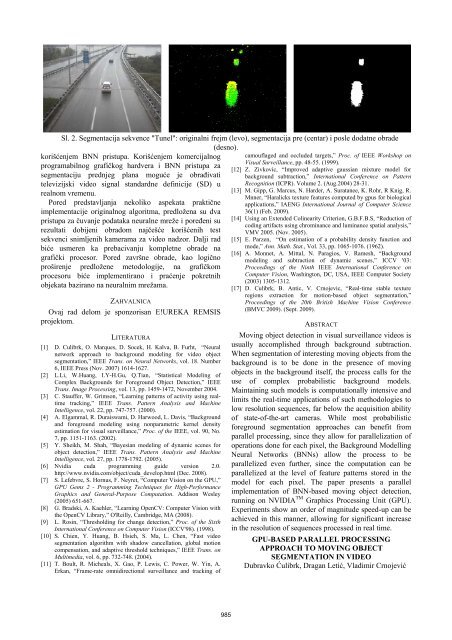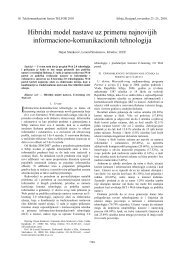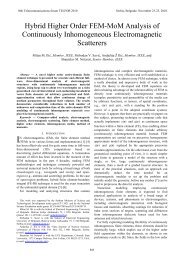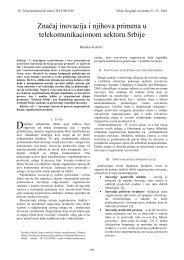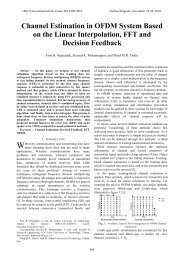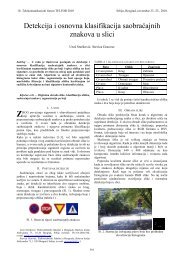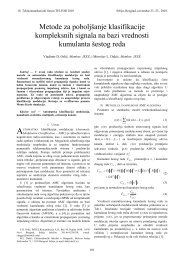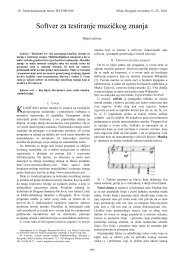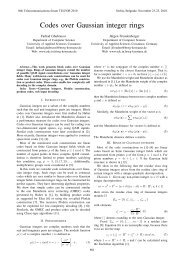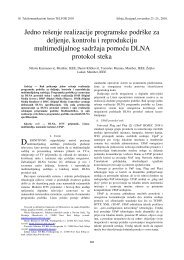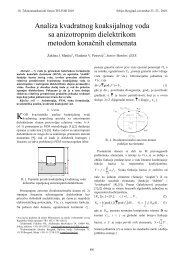TELFOR 2006 - 18. telekomunikacioni forum TELFOR 2010 - Telfor
TELFOR 2006 - 18. telekomunikacioni forum TELFOR 2010 - Telfor
TELFOR 2006 - 18. telekomunikacioni forum TELFOR 2010 - Telfor
Create successful ePaper yourself
Turn your PDF publications into a flip-book with our unique Google optimized e-Paper software.
Sl. 2. Segmentacija sekvence "Tunel": originalni frejm (levo), segmentacija pre (centar) i posle dodatne obrade<br />
(desno).<br />
korišenjem BNN pristupa. Korišenjem komercijalnog<br />
programabilnog grafikog hardvera i BNN pristupa za<br />
segmentaciju prednjeg plana mogue je obraivati<br />
televizijski video signal standardne definicije (SD) u<br />
realnom vremenu.<br />
Pored predstavljanja nekoliko aspekata praktine<br />
implementacije originalnog algoritma, predložena su dva<br />
pristupa za uvanje podataka neuralne mreže i poreeni su<br />
rezultati dobijeni obradom naješe korišenih test<br />
sekvenci snimljenih kamerama za video nadzor. Dalji rad<br />
bie usmeren ka prebacivanju kompletne obrade na<br />
grafiki procesor. Pored završne obrade, kao logino<br />
proširenje predložene metodologije, na grafikom<br />
procesoru bie implementirano i praenje pokretnih<br />
objekata bazirano na neuralnim mrežama.<br />
ZAHVALNICA<br />
Ovaj rad delom je sponzorisan E!UREKA REMSIS<br />
projektom.<br />
[1]<br />
LITERATURA<br />
D. Culibrk, O. Marques, D. Socek, H. Kalva, B. Furht, “Neural<br />
network approach to background modeling for video object<br />
segmentation,” IEEE Trans. on Neural Networks, vol. <strong>18.</strong> Number<br />
6, IEEE Press (Nov. 2007) 1614-1627.<br />
[2] L.Li, W.Huang, I.Y-H.Gu, Q.Tian, “Statistical Modeling of<br />
Complex Backgrounds for Foreground Object Detection,” IEEE<br />
Trans. Image Processing, vol. 13, pp. 1459-1472, November 2004.<br />
[3] C. Stauffer, W. Grimson, “Learning patterns of activity using realtime<br />
tracking,” IEEE Trans. Pattern Analysis and Machine<br />
Intelligence, vol. 22, pp. 747-757. (2000).<br />
[4] A. Elgammal, R. Duraiswami, D. Harwood, L. Davis, “Background<br />
and foreground modeling using nonparametric kernel density<br />
estimation for visual surveillance,” Proc. of the IEEE, vol. 90, No.<br />
7, pp. 1151-1163. (2002).<br />
[5] Y. Sheikh, M. Shah, “Bayesian modeling of dynamic scenes for<br />
object detection,” IEEE Trans. Pattern Analysis and Machine<br />
Intelligence, vol. 27, pp. 1778-1792. (2005).<br />
[6] Nvidia cuda programming guide version 2.0.<br />
[7]<br />
http://www.nvidia.com/object/cuda_develop.html (Dec. 2008).<br />
S. Lefebvre, S. Hornus, F. Neyret, “Computer Vision on the GPU,”<br />
GPU Gems 2 - Programming Techniques for High-Performance<br />
Graphics and General-Purpose Computation. Addison Wesley<br />
(2005) 651-667.<br />
[8] G. Bradski, A. Kaehler, “Learning OpenCV: Computer Vision with<br />
the OpenCV Library,” O'Reilly, Cambridge, MA (2008).<br />
[9] L. Rosin, “Thresholding for change detection,” Proc. of the Sixth<br />
International Conference on Computer Vision (ICCV'98). (1998).<br />
[10] S. Chien, Y. Huang, B. Hsieh, S. Ma, L. Chen, “Fast video<br />
segmentation algorithm with shadow cancellation, global motion<br />
compensation, and adaptive threshold techniques,” IEEE Trans. on<br />
Multimedia, vol. 6, pp. 732-748. (2004).<br />
[11] T. Boult, R. Micheals, X. Gao, P. Lewis, C. Power, W. Yin, A.<br />
Erkan, “Frame-rate omnidirectional surveillance and tracking of<br />
985<br />
camouflaged and occluded targets,” Proc. of IEEE Workshop on<br />
Visual Surveillance, pp. 48-55. (1999).<br />
[12] Z. Zivkovic, “Improved adaptive gaussian mixture model for<br />
background subtraction,” International Conference on Pattern<br />
Recognition (ICPR). Volume 2. (Aug.2004) 28-31.<br />
[13] M. Gipp, G. Marcus, N. Harder, A. Suratanee, K. Rohr, R Knig, R.<br />
Mnner, “Haralicks texture features computed by gpus for biological<br />
applications,” IAENG International Journal of Computer Science<br />
36(1) (Feb. 2009).<br />
[14] Using an Extended Colinearity Criterion, G.B.F.B.S, “Reduction of<br />
coding artifacts using chrominance and luminance spatial analysis,”<br />
VMV 2005. (Nov. 2005).<br />
[15] E. Parzen, “On estimation of a probability density function and<br />
mode,” Ann. Math. Stat., Vol. 33, pp. 1065-1076. (1962).<br />
[16] A. Monnet, A. Mittal, N. Paragios, V. Ramesh, “Background<br />
modeling and subtraction of dynamic scenes,” ICCV '03:<br />
Proceedings of the Ninth IEEE International Conference on<br />
Computer Vision, Washington, DC, USA, IEEE Computer Society<br />
(2003) 1305-1312.<br />
[17] D. Culibrk, B. Antic, V. Crnojevic, “Real-time stable texture<br />
regions extraction for motion-based object segmentation,”<br />
Proceedings of the 20th British Machine Vision Conference<br />
(BMVC 2009). (Sept. 2009).<br />
ABSTRACT<br />
Moving object detection in visual surveillance videos is<br />
usually accomplished through background subtraction.<br />
When segmentation of interesting moving objects from the<br />
background is to be done in the presence of moving<br />
objects in the background itself, the process calls for the<br />
use of complex probabilistic background models.<br />
Maintaining such models is computationally intensive and<br />
limits the real-time applications of such methodologies to<br />
low resolution sequences, far below the acquisition ability<br />
of state-of-the-art cameras. While most probabilistic<br />
foreground segmentation approaches can benefit from<br />
parallel processing, since they allow for parallelization of<br />
operations done for each pixel, the Background Modelling<br />
Neural Networks (BNNs) allow the process to be<br />
parallelized even further, since the computation can be<br />
parallelized at the level of feature patterns stored in the<br />
model for each pixel. The paper presents a parallel<br />
implementation of BNN-based moving object detection,<br />
running on NVIDIA TM Graphics Processing Unit (GPU).<br />
Experiments show an order of magnitude speed-up can be<br />
achieved in this manner, allowing for significant increase<br />
in the resolution of sequences processed in real time.<br />
GPU-BASED PARALLEL PROCESSING<br />
APPROACH TO MOVING OBJECT<br />
SEGMENTATION IN VIDEO<br />
Dubravko ulibrk, Dragan Leti, Vladimir Crnojevi


